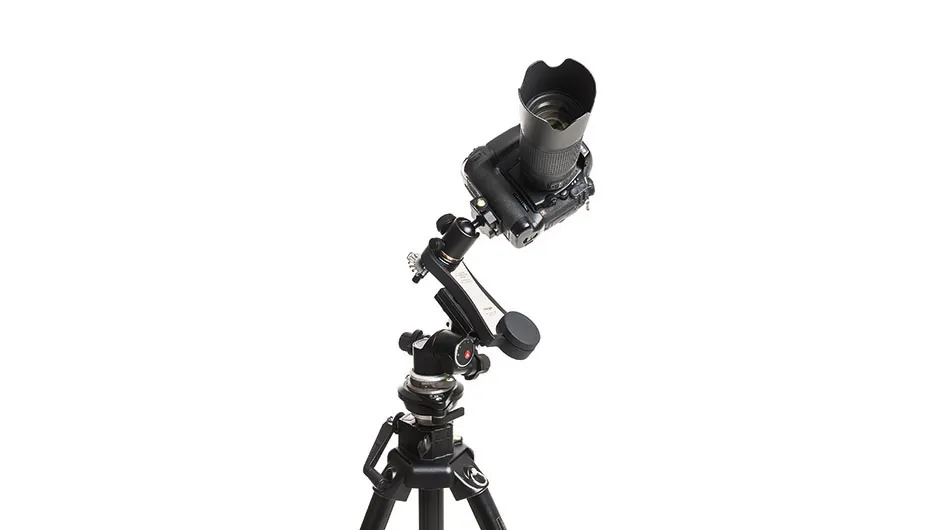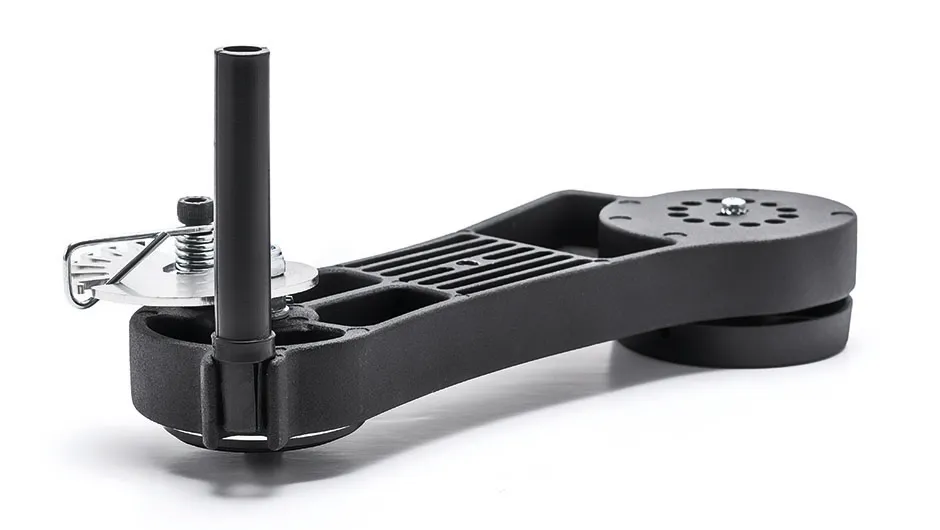Historically, the drives and gears used to motorise telescope mounts have been known as ‘clock drives’ because the original mechanisms had much in common with early clocks, which used weights and pendulums to keep time.The Omegon MiniTrack LX2 brings this older technology bang up to date by using a clockwork motor to power a compact equatorial tracking mount that can handle a payload up to 2kg and focal lengths up to 100mm.
Until now, similar ultra-portable tracking mounts have used small electric motors and electronic control circuits to accurately rotate the right ascension (RA) axis.The MiniTrack is, therefore, quite a departure from the well-trodden path.
This elegant solution means that an ultra-portable mount can be taken anywhere without having to rely on any power requirements other than a little bit of wrist action every hour or so to gently wind up the clock mechanism.This is, perhaps, the first truly eco-friendly mount.
Such an unusual piece of equipment demanded our attention, so we were keen to give it a run.Its arrival in the summer months was ideal for some wide-field Milky Way imaging with a camera and lens, which is what this mount is designed for rather than a small telescope.

The mount weighs in at 464g (774g with the supplied ball-and-socket head installed) and is just 215mm long by 80mm wide at its widest point, making it almost pocketable.The chassis is a single aluminium casting with a black crackle finish and highly polished components.
Attached to one end is a quadrant arm with a rubber platform onto which the substantial ball-and-socket head is attached via a ¾-16 bolt.
If you opt to buy the mount-only version of the MiniTrack you can use your own ball-and-socket head and, if necessary, change the mounting bolt to the ¼-20 bolt supplied, using the spanner and adaptor included in the kit.
A moulded clip at the top of the chassis holds a small plastic sighting tube to assist in polar alignment.
Assembling the system is very quick indeed. You start by attaching the MiniTrack to your own tripod’s pan-and-tilt head or precision altaz head so that you can tilt the star tracker to polar align it. You then attach the ball-and-socket head to the mounting platform.
Finally, you attach the camera and lens to the quick release dovetail bar.Next up is polar alignment, which you carry out by sighting Polaris through the polar finder tube then locking the tripod’s head firmly in position.

This alignment process was a little subjective but for wide-angle imaging it proved to be perfectly adequate.It should be noted, though, that the MiniTrack will only track the night sky in the northern hemisphere.
Once the mount is correctly polar aligned you then attach the camera to the ball-and-socket head using the dovetail clamp, which we easily managed to achieve even in the dark.
To start the imaging session, you turn the large disc at the foot of the mount a maximum of one rotation to wind up the clockwork motor – it’s as simple as that.
Once the motor’s running, you can loosen the ball-and-socket head to allow the camera lens to point to the celestial object you want to photograph and, after focussing, image capturing can begin.
We used an external intervalometer attached to our Canon 450D and 28mm wide-angle lens set to capture a continuous set of three-minute exposures with the camera in ‘bulb’ mode.
We used our own hot shoe-mounted red dot finder to aim the lens in the general direction of the bright star Sadr (Gamma (γ) Cygni) in Cygnus, and captured images until the motor ran out, which was exactly an hour later.
The resulting star shapes were impressive, showing no sign of trailing even though we were using the maximum exposure length recommended for our camera and lens combination.
We would recommend the MiniTrack to users of any experience level as a simple means of mounting basic imaging equipment for wide-field imaging.

Outstanding feature: A timer with teeth
For accurate tracking on an equatorial mount, the larger the diameter of the final gear in the drive chain, the better.However, this would be at odds with the goal of portability.
Using a quadrant arm has the advantage of using an apparently large drive gear in a small physical size as only a small part of the perimeter of the ‘complete’ gear is required.
In the case of the MiniTrack, the arm represents a section of a gear that would have a diameter of 290mm.
Although quadrant arms have been used in other designs before, what makes this product so unusual is the clockwork motor that drives the arm.The motor used in this design is essentially a one-hour timer installed at one end of the body.
It even pings at the end of the run to alert you to the fact that the hour is up.The clockwork motor engages with a series of intermediary gears that ultimately move the quadrant arm via a set of teeth on its curved outer edge.

Omegon MiniTrack LX2 tracking mount key features
Ball-and-socket head
There is no declination axis on this type of mount so the camera and lens have to be attached to a ball-and-socket head so that they can point to anywhere in the sky.The beautifully engineered Omegon ball-and-socket head supplied as part of the MiniTrack kit makes pointing at celestial objects very straightforward.
Miniature saddle clamp
The ball-and-socket head has a well-designed saddle clamp with a single, very positive-feeling hand bolt.This saddle clamps a mini-dovetail bar forming an excellent quick release mechanism for easy attachment and removal.Two discrete detents that slot into grooves stop the bar from falling out by accident.
¼-inch tripod mount
The rear of the mount has a standard ¼-20, UNC-threaded mounting hole right in the centre of the casting.This allows the MiniTrack to be attached to a wide range of tripod heads and equatorial wedges.We used a Manfrotto 410 geared head to attach the mount, allowing simple adjustment of altitude.
Counterblance spring
It’s not always possible to achieve perfect balance with a camera and lens and there is no counterbalance shaft with weights in this tracker’s design.Instead, a seven-level spring tensioner is built into the mounting head to help alleviate any off-balance pressure being applied to the clockwork drive mechanism.
Polar finder
Equatorial mounts require polar alignment to avoid star trails and field rotation during long exposures.The MiniTrack is supplied with a very simple polar finder comprising an 8mm sighting tube that fits into a clip on the end of the drive unit.Visually aligning with Polaris through this tube achieves an approximate polar alignment, which works well enough
Vital stats
Price: £109.00
Weight:774g
Supplier: Astroshop.de
Telephone: 0049 8191 940491
Website:www.astroshop.de
This review originally appeared in the October 2018 issue of BBC Sky at Night Magazine
